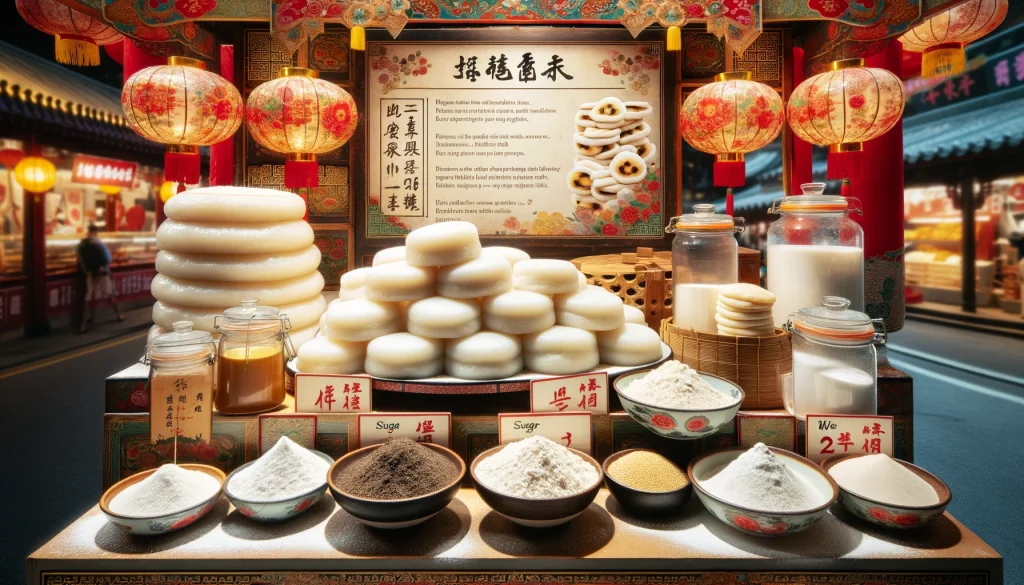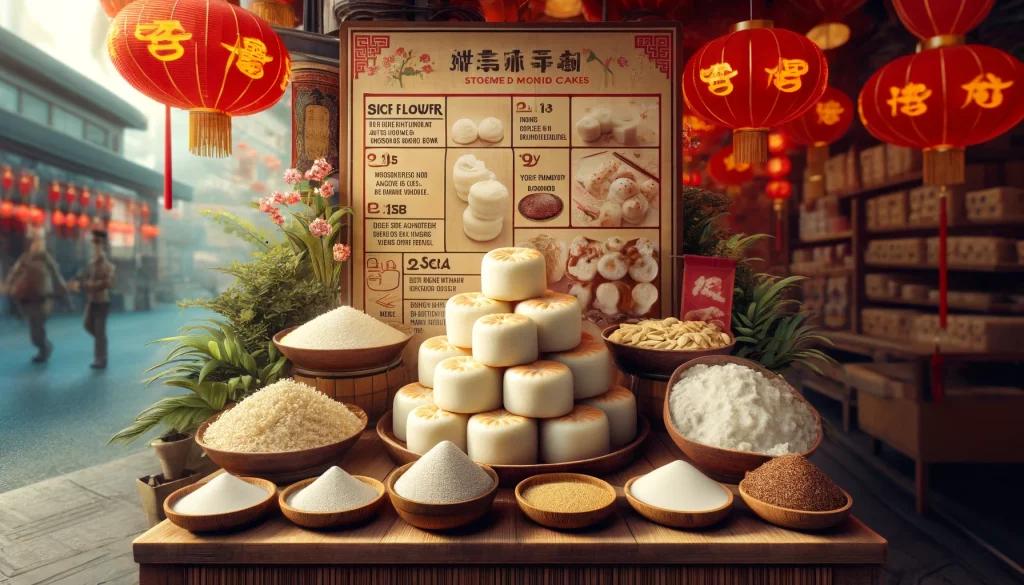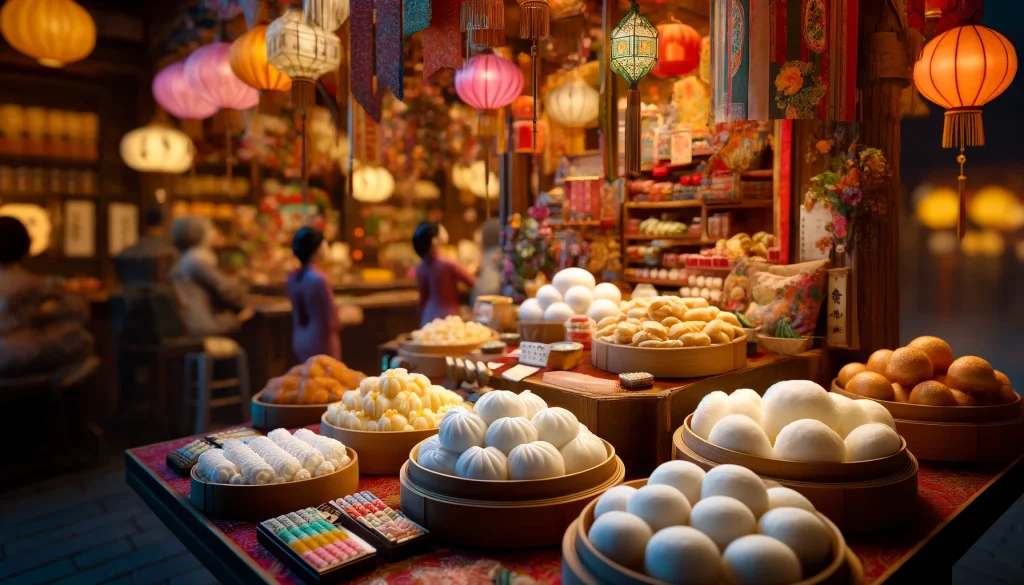As an Amazon Associate I earn from qualifying purchases.
In the vast tapestry of traditional desserts that dot the culinary landscape of China, the Bai Tang Gao, or Chinese Steamed Rice Cake, holds a special place. This quintessential treat, beloved for its delightfully spongy texture and subtly sweet flavor, offers a window into the rich cultural heritage and culinary traditions of China. Made from simple, humble ingredients such as rice flour, sugar, and yeast, Bai Tang Gao exemplifies the elegance of Chinese cuisine, where the emphasis is often on enhancing the natural flavors and textures of the ingredients. The process of fermentation, which is key to achieving the cake’s characteristic airiness and slight tang, speaks to the patience and care imbued in traditional cooking methods. As we delve into the recipe for this timeless delicacy, we uncover not just the steps to create it, but also the story of a dessert that has been cherished through generations, evolving yet remaining true to its roots. Whether enjoyed as part of a festive celebration or as a comforting treat, Bai Tang Gao continues to enchant palates with its unique texture and taste, standing as a testament to the enduring appeal of traditional Chinese desserts.
Chinese Steamed Rice Cake Recipe

Chinese Steamed Rice Cake, often referred to as “Bai Tang Gao” (白糖糕) in Mandarin, is a traditional, sweet dessert known for its delightfully spongy texture and slightly sweet taste. Unlike the spicy and savory Korean Tteokbokki, this steamed cake offers a unique experience derived from its fermentation process, which gives it a characteristic slight tanginess. Here’s a basic recipe to get you started on making your own Bai Tang Gao at home:
Ingredients:
- Rice Flour: 1 cup (not glutinous rice flour)
- Sugar: 1 cup (white sugar is traditional, but you can adjust the type and amount according to taste)
- Water: 1 ½ cups (divided into 1 cup for dissolving the sugar and ½ cup for mixing with the rice flour)
- Active Dry Yeast: 1 teaspoon
- Warm Water: To activate the yeast (approximately ¼ cup)
- A pinch of Salt (optional)
Instructions:
- Yeast Mixture: Start by activating the yeast. Mix the active dry yeast with about ¼ cup of warm water (not too hot, or it will kill the yeast). Let it sit for about 5-10 minutes until it becomes frothy.
- Sugar Syrup: In a small pot, dissolve the sugar in 1 cup of water over low heat. Allow it to cool to room temperature.
- Mixing: In a large mixing bowl, combine the rice flour with ½ cup of water and the pinch of salt. Stir until smooth. Then, add the cooled sugar syrup and the activated yeast mixture to the rice flour mixture. Stir well until everything is fully incorporated and smooth.
- Fermentation: Cover the bowl with a clean cloth and let it ferment in a warm place for about 1-2 hours, or until the mixture doubles in size and shows bubbles on the surface.
- Steaming: Once the batter has fermented, stir it gently to release some of the air bubbles. Pour the batter into a greased cake pan or individual molds. Steam over high heat for about 20-30 minutes, or until a toothpick inserted into the center comes out clean. The steaming time may vary depending on the thickness of the cake.
- Cooling and Serving: Let the cake cool slightly before removing it from the pan. It’s best served warm or at room temperature. The cake should have a soft, spongy texture and a slightly sweet taste.
Tips:
- Fermentation Time: The key to a successful Bai Tang Gao is the fermentation time. The environment’s temperature can affect this, so it might take longer in colder climates. Look for the batter to double in size and become bubbly.
- Texture: For a finer texture, some recipes recommend blending the batter before the fermentation process. This can help break down any lumps and incorporate air into the mixture.
- Flavor Variations: While traditional Bai Tang Gao is mildly sweet, you can add various flavors to the batter, such as pandan extract, vanilla, or almond extract, for a different twist.
Bai Tang Gao is a delightful treat that embodies the simplicity and elegance of traditional Chinese desserts. Its unique texture and flavor make it a favorite among those who appreciate the subtleties of steamed cakes. Whether enjoyed as a dessert, breakfast, or snack, this steamed rice cake offers a comforting taste of tradition with every bite.
Expert Tips
Creating the perfect Chinese Steamed Rice Cake (Bai Tang Gao) requires a blend of traditional techniques and careful attention to detail. Here are some expert tips to help you elevate your Bai Tang Gao to the next level:
- Choosing the Right Rice Flour: Use fine rice flour for a smoother texture. Do not confuse rice flour with glutinous rice flour, as they yield different textures. Glutinous rice flour makes the cake chewy, while regular rice flour results in a soft and spongy cake.
- Optimal Fermentation Conditions: The fermentation process is crucial for achieving the characteristic spongy texture and slight tanginess. Ensure the batter is kept in a warm, draft-free environment to facilitate yeast activity. The temperature should ideally be around 75°F-80°F (24°C-27°C). If your kitchen is cool, consider placing the batter in an oven with the light on for gentle warmth.
- Sugar Syrup Consistency: The sugar syrup should be fully dissolved and cooled to room temperature before adding to the rice flour mixture. If the syrup is too hot, it can kill the yeast, hindering fermentation.
- Avoid Over-mixing After Fermentation: Once the batter has fermented and risen, gently stir it to release some air bubbles. Over-mixing at this stage can deflate the batter, affecting the cake’s texture.
- Steamer Preparation: Ensure the water in your steamer is boiling before placing the cake batter inside. A vigorous steam helps cook the cake evenly and achieve a consistent texture throughout.
- Cover with Cloth: To prevent water from condensing on the lid and dripping onto the cake, wrap the lid of your steamer with a cloth. This absorbs the condensation and prevents the cake’s surface from becoming wet and uneven.
- Test for Doneness: Like other cakes, a toothpick or a skewer inserted into the center of the cake should come out clean when it’s done. Depending on the thickness of the cake and the type of steamer, cooking times may vary, so it’s important to check for doneness rather than strictly adhering to a timer.
- Cooling: Allow the cake to cool slightly before unmolding. This makes it easier to remove from the pan and helps set the texture, making it less sticky to cut.
- Serving: Bai Tang Gao is traditionally enjoyed at room temperature or slightly warm. Cutting the cake with a plastic knife or a thread can prevent it from sticking and help maintain its shape.
- Experiment with Flavors: While traditional Bai Tang Gao is mildly sweet and subtly flavored, don’t hesitate to experiment with additions like pandan for a fragrant twist or brown sugar for a deeper flavor profile.
By following these expert tips, you can master the art of making Chinese Steamed Rice Cake, delighting in its unique texture and flavor that’s been cherished for generations.
Why This Recipe Is Just So Good…

The Chinese Steamed Rice Cake, or Bai Tang Gao, stands out as a beloved culinary delight for several compelling reasons, making it a cherished recipe across generations:
- Unique Texture: The most distinctive feature of Bai Tang Gao is its soft, spongy texture paired with a slightly chewy consistency. This texture is achieved through the fermentation process, which introduces air bubbles into the batter, resulting in a cake that is both light and satisfying to eat.
- Subtle Sweetness: Bai Tang Gao’s mild sweetness is appealing to those who prefer desserts that are not overly sugary. The sweetness is carefully balanced to complement the natural flavors of the rice flour, making it a versatile treat that can be enjoyed at any time of the day.
- Cultural Tradition: Bai Tang Gao has deep roots in Chinese cuisine and culture, often associated with festivities, family gatherings, and traditional celebrations. Its preparation and enjoyment connect people to their heritage and cultural practices, adding a layer of emotional significance to the culinary experience.
- Simple Ingredients: The recipe for Bai Tang Gao relies on minimal and easily accessible ingredients, making it a straightforward and approachable dish for home cooks. Its simplicity belies the depth of flavor and texture that can be achieved, showcasing the principle that great food does not need to be complicated.
- Versatility in Flavor: While traditional Bai Tang Gao is enjoyed for its original taste, the recipe can be easily adapted to include various flavors such as pandan, almond, or even cocoa, allowing for creativity in the kitchen. This versatility ensures that the recipe remains fresh and exciting, with each variation offering a new experience.
- Digestibility: Compared to many Western-style cakes that are rich in fats and sugars, Bai Tang Gao is lighter and less dense, making it easier on the stomach. Its digestibility makes it an excellent option for a snack or a light dessert, suitable even after a hearty meal.
- Gluten-Free: For those with gluten sensitivities or celiac disease, Bai Tang Gao is a naturally gluten-free dessert option, as it’s made with rice flour. This inclusivity allows more people to enjoy the pleasures of a beautifully steamed cake without dietary concerns.
In essence, the appeal of the Chinese Steamed Rice Cake lies in its delightful texture, nuanced sweetness, cultural significance, and the joy of creating something beautiful from simple ingredients. It’s a testament to the enduring legacy of traditional recipes and their ability to bring joy and satisfaction across generations.
Storage Instructions
Storing Chinese Steamed Rice Cake (Bai Tang Gao) properly is essential to maintain its unique texture and flavor. Here are some guidelines on how to store it:
Short-term Storage:
- Cool Down: Allow the steamed rice cake to cool to room temperature after cooking. This prevents condensation from forming inside the storage container, which could make the cake soggy.
- Airtight Container: Once cooled, place the rice cake in an airtight container. This helps to keep out moisture and other contaminants, preserving its freshness.
- Refrigerate: Store the container in the refrigerator if you plan to consume the rice cake within a few days. It should stay good for about 2-3 days.
Long-term Storage:
- Freezing: For longer storage, you can freeze the rice cake. Wrap individual slices or the whole cake in cling film or plastic wrap tightly to prevent freezer burn and then place it in a freezer bag or airtight container.
- Thawing and Reheating: When ready to eat, thaw the rice cake in the refrigerator overnight. To restore its soft texture, steam it for a few minutes or microwave it with a wet paper towel covering the cake to add moisture back into it.
Reheating:
- Steaming: Steaming the rice cake is the best way to reheat it, as it helps retain the moisture, keeping the cake soft and fluffy. Simply steam for about 5-10 minutes, depending on the size and thickness.
- Microwave: If you’re in a hurry, you can also microwave the rice cake. Place a damp paper towel over the cake to prevent it from drying out, and heat it on medium power for short intervals, checking for desired warmth and texture.
Tips for Best Quality:
- Consume Fresh: While storage is possible, Bai Tang Gao is best enjoyed fresh. The unique, airy texture of the cake is most prominent when it’s just been steamed and slightly cooled.
- Avoid Direct Sunlight: Keep the stored rice cake away from direct sunlight and heat sources to prevent it from spoiling or drying out.
Following these storage instructions will help ensure that your Chinese Steamed Rice Cake remains delicious and retains its texture for as long as possible, allowing you to enjoy this traditional dessert even days after making it.
Frequently Asked Questions (FAQ)

Q: What is Chinese Steamed Rice Cake?
A: Chinese Steamed Rice Cake, known as Bai Tang Gao in Mandarin, is a traditional Chinese dessert made from rice flour, sugar, and yeast. It is known for its sweet taste and spongy, airy texture, achieved through fermentation and steaming.
Q: What ingredients are needed for Bai Tang Gao?
A: The basic ingredients include rice flour (not glutinous rice flour), sugar, water, and active dry yeast. Some variations may include additional flavorings such as pandan extract or vanilla for a unique taste.
Q: How long does it take to make Bai Tang Gao?
A: The preparation time is relatively short, but the fermentation process can take anywhere from 1 to 2 hours, depending on the room temperature. After fermentation, steaming takes about 20-30 minutes. So, the total time from start to finish is approximately 2-3 hours.
Q: Can I use glutinous rice flour instead of regular rice flour?
A: No, glutinous rice flour will result in a sticky and chewy texture, whereas regular rice flour yields the desired soft and spongy texture. It’s important to use non-glutinous rice flour for Bai Tang Gao.
Q: Why does my Bai Tang Gao not have a spongy texture?
A: A non-spongy texture can result from several factors, including insufficient fermentation time, which doesn’t allow enough air bubbles to form; using expired yeast, which doesn’t activate properly; or overmixing the batter after fermentation, which can deflate the batter.
Q: How do I know when the Bai Tang Gao is fully cooked?
A: Insert a toothpick or a skewer into the center of the cake. If it comes out clean, the cake is fully cooked. Additionally, the cake should have a slight bounce back when lightly pressed with a finger.
Q: Can Bai Tang Gao be flavored with other ingredients?
A: Yes, Bai Tang Gao can be flavored with a variety of ingredients. Popular options include pandan extract for a fragrant flavor, cocoa powder for a chocolate version, or almond extract for a nutty taste. Add these flavors to the batter before the fermentation process.
Q: How should Bai Tang Gao be stored?
A: Bai Tang Gao should be stored in an airtight container to prevent it from drying out. It can be kept at room temperature for 1 day or refrigerated for up to 3 days. For longer storage, it can be frozen and then reheated by steaming or microwaving with a wet paper towel.
Q: Can I make Bai Tang Gao without a steamer?
A: While a steamer is ideal, you can create a makeshift steamer using a pot with a lid and a heat-proof rack or stand to elevate the cake pan above water. Ensure the pot is covered tightly to keep the steam inside.
Q: Is Bai Tang Gao gluten-free?
A: Yes, Bai Tang Gao is naturally gluten-free because it is made with rice flour instead of wheat flour. This makes it a suitable dessert option for those with gluten sensitivities or celiac disease.
Q: What is the key to achieving the perfect spongy texture in Bai Tang Gao?
A: The key to achieving the perfect spongy texture in Bai Tang Gao lies in the fermentation process. Using active dry yeast and allowing the batter to ferment in a warm environment causes it to rise and incorporate air, leading to a light and spongy texture. Ensuring the batter is at the right consistency and properly fermented before steaming is crucial.
Q: Can I use glutinous rice flour instead of regular rice flour for making Bai Tang Gao?
A: No, glutinous rice flour should not be used as a substitute for regular rice flour in Bai Tang Gao. Glutinous rice flour will result in a chewy and sticky texture, whereas regular rice flour yields the characteristic soft and spongy texture associated with Bai Tang Gao.
Q: How can I prevent the rice cake from becoming too dense?
A: To prevent the rice cake from becoming too dense, make sure not to overmix the batter after fermentation, as this can deflate the air bubbles necessary for a light and spongy texture. Additionally, ensure the yeast is active and the batter is properly fermented to create enough airiness within the cake.
Q: Is there a way to make Bai Tang Gao if I don’t have a steamer?
A: If you don’t have a traditional steamer, you can create a makeshift steamer using a large pot with a lid and a heat-proof dish or rack to elevate the cake pan above water level. Ensure the lid is tight-fitting to trap the steam, and wrap it with a cloth to prevent water condensation from dripping onto the cake.
Q: How do I know if the cake is fully cooked?
A: To check if Bai Tang Gao is fully cooked, insert a toothpick or a skewer into the center of the cake. If it comes out clean without any batter attached, the cake is done. The texture should be spongy and slightly springy to the touch.
Q: Can I flavor Bai Tang Gao with ingredients other than sugar?
A: Yes, Bai Tang Gao can be flavored with various ingredients to add depth or a twist to the traditional recipe. Popular additions include pandan extract for a fragrant aroma and green color, cocoa powder for a chocolate version, or almond extract for a nutty flavor. Incorporate these flavors into the batter before fermentation.
Q: How long can Bai Tang Gao be stored without losing its texture?
A: Bai Tang Gao can be stored in the refrigerator for 2-3 days without a significant loss in texture. For longer storage, it can be frozen for up to a month. However, reheating it properly by steaming or microwaving with a damp towel is crucial to restoring its soft and spongy texture.
Q: What are some common mistakes to avoid when making Bai Tang Gao?
A: Common mistakes include not dissolving the sugar completely, which can affect the fermentation; using water that is too hot for the yeast, killing the active cultures; overmixing the batter after fermentation, which deflates the air bubbles; and not steaming at a consistent high temperature, which can result in uneven cooking.
Conclusion
As we wrap up our exploration of the Chinese Steamed Rice Cake, or Bai Tang Gao, it’s clear that this traditional dessert is much more than a simple confection. It is a testament to the artistry and ingenuity of Chinese culinary traditions, where minimal ingredients transform through patience and skill into a dish with complex textures and flavors. The process of making Bai Tang Gao, from fermenting the batter to steaming it to perfection, is a delightful exercise in the principles of simplicity and harmony that underlie much of Chinese cuisine. This cake not only offers a delicious treat but also connects those who make and enjoy it to centuries of cultural history and culinary practice. In every bite, there’s a piece of heritage, a taste of home, and a reminder of the simple pleasures that food can bring. Whether you’re a seasoned baker or a curious novice, making Bai Tang Gao is an opportunity to engage with a rich culinary tradition and perhaps, find a new favorite dessert in the process. As we continue to explore and celebrate the diverse flavors of the world’s cuisines, the Chinese Steamed Rice Cake stands out as a humble yet profound reminder of the beauty and depth that traditional recipes offer.






